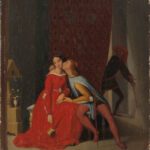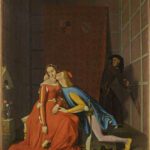Ingres, Jean Auguste Dominique (1780-1867)
Paolo et Francesca (Paolo and Francesca)
1814
Oil on canvas, 35.3 cm x 28.4 cm
Musée Condé, Chantilly
The subject is taken from Inferno in Dante‘s Divine Comedy (14th century). It is, with the Stratonice, the only love scene that Ingres painted. In 1289, Francesca da Rimini, forced to marry the old Giovanni Malatesta, lame and deformed, fell in love with her husband’s brother, the young Paolo. Paolo and Francesca, reading a romance novel together, are surprised during a guilty kiss by the jealous husband who kills them both. The subject was made fashionable by Silvio Pellico’s Francesca da Rimini, performed in Italy by the Marchioni around 1815. Ingres treats this drama in the manner of troubadour painting, combining two critical moments: the birth of love and the dead. The book falls from Francesca‘s hands, while Paolo tries to kiss her and she turns away; the old husband then appears and draws his sword.
Despite this drama, the painting is cold and static, because Ingres is inspired by Italian primitive painting – box-shaped space, brilliant colors, precision of contours – as well as Flaxman for this scene, with a linear purism . The naturalism of the Flemish primitives is evoked by the multitude of miniaturist details: notches in Francesca‘s hairbands, shimmering, the hilt of the sword. Between 1813 and 1819 Ingres devoted himself to historical genre paintings in the style of “troubadour” painting. These small historical paintings are designed as intimate scenes with a smooth, precise rendering, in the style of Dutch painters. The Chantilly copy is Dutch in its precious workmanship and coloring, in the rigorous construction of the space by the accentuation of verticals and horizontals, and by the precise description of the accessories and details. Ingres, then close to the Nazarene painters in Rome, shared their taste for painting from the Middle Ages to Dürer and Raphael.
Ingres treated this theme twice during his stay in Italy, in 1814 and 1819, and seven times in total between 1814 and 1850; the Chantilly version was painted for Caroline Murat, Queen of Naples, Napoleon‘s sister, in 1814, and acquired with the collection of the Prince of Salerno by the Duke of Aumale in 1854. The seven known versions are all different, Ingres, eternally dissatisfied, introducing sometimes significant variations. (Musée Condé)
Compare:
 Ingres, Jean Auguste Dominique (1780-1867)
Ingres, Jean Auguste Dominique (1780-1867)
Francesca da Rimini et Paolo Malatesta
1819
Musée Bonnat-Helleu, Bayonne
 Ingres, Jean Auguste Dominique (1780-1867)
Ingres, Jean Auguste Dominique (1780-1867)
Paolo et Francesca
1819
Musée des Beaux-Arts, Angers
See also:
• Alighieri, Dante (1265-1321) | Francesca da Rimini (c.1255-1285) | Malatesta, Gianciotto (c.1245-1304) | Malatesta, Paolo (c.1246-1285)
